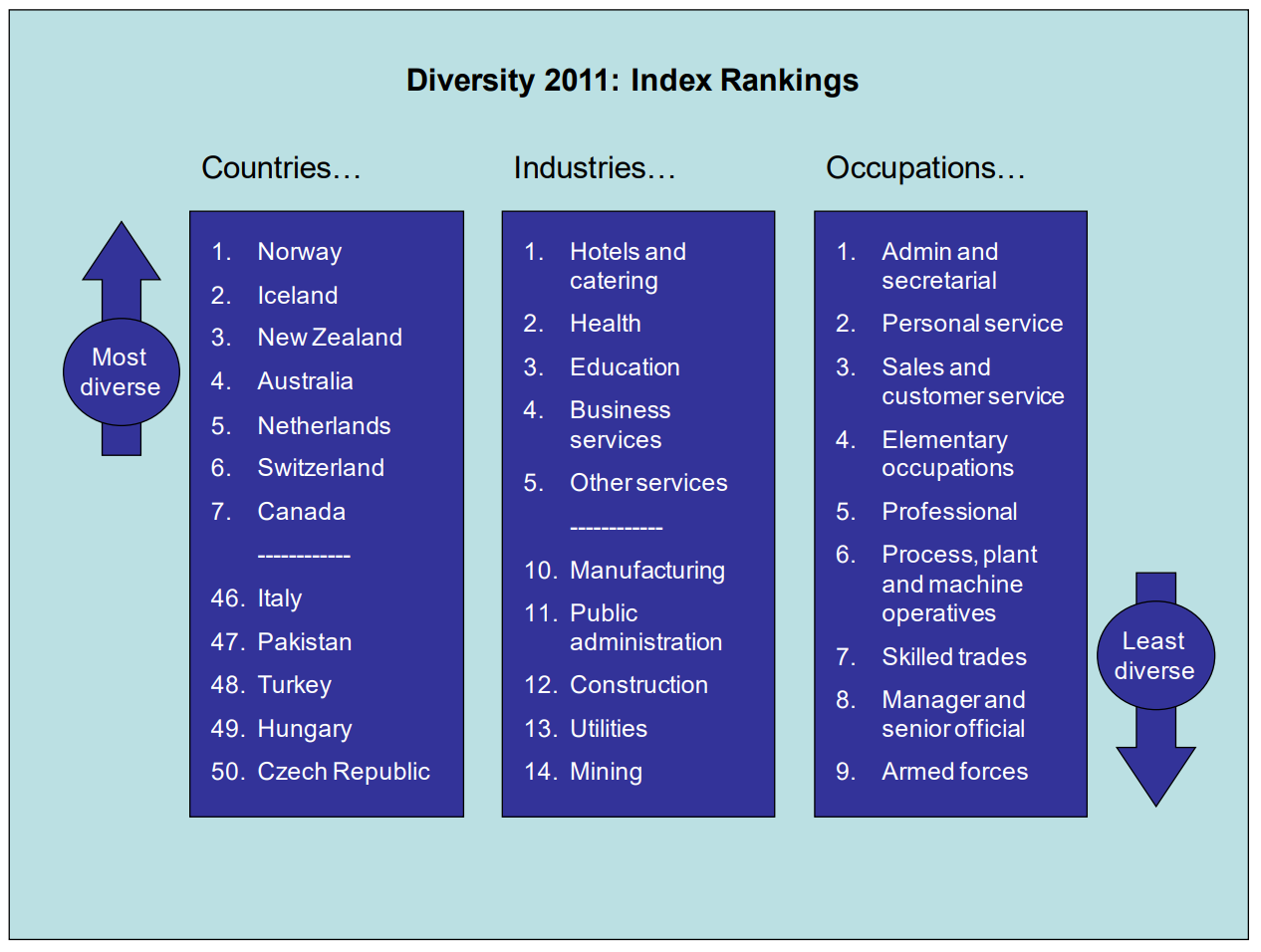Thinking about where your own company stands in terms of diversity is a complex process in itself. Extending that view to your city, country, and eventually, the global economy as a whole becomes ever more intensive and complicated. However, this practice is crucial to creating diversity across different countries because in order to grow together we must recognize where we currently stand apart.

Diversity 2011: Index Rankings From Most to Least Diverse
Countries
- Norway
- Iceland
- New Zealand
- Australia
- Netherlands
- Switzerland
- Canada
Industries
- Hotels and catering
- Health
- Education
- Business services
Occupations
- Admin and secretarial
- Personal service
- Sales and customer service
- Elementary occupations
- Professional
- Process, plant and machine operatives
- Skill trades
- Manager and senior official
- Armed forces
Oxford Economics created a comprehensive Global Diversity Report, benchmarking 50 countries against one another with a model that factors in gender, age, sector and ethnicity — among several other uniquely weighted categories. The report is a phenomenal reference for more insight, but the important takeaway is linked to the countries and industries that are succeeding, and in particular, recognizing what they are doing differently.
NORWAY’S WINNING SECRET
A key factor in Norway’s top position is the country’s impressive gender distribution, especially at the corporate level. The balance they have achieved did not come about unprovoked, unfortunately, but their success is evidence that hard mandates are in fact effective. In 2007, the legislation that all publicly listed corporations have at least 40% female board members took effect. As a result, Norwegian boards have achieved an average of 42% gender diversity (2016).
This has had an impact on many other European countries, who are following suit and putting similar quotas in place. Soft laws, guidelines, and comply-or-explain provisions are more common and easier to enact, but even without enforcement, they have shown to yield promising results. In 2015, The UK set a target for FTSE 100 companies of 25% female boards and surpassed this the following year. Currently, the goal has been increased to 33% by 2020 for FTSE 350 boards, which reached 30% in 2019.
Quotas are controversial by nature, and there will always be disadvantages to something so overarching and generalized. The systems in place are by no means perfect, but it is easy to see the potential and value of the core ideas that drive them. We can not count on all countries enacting the same sorts of quotas, but that does not mean businesses should not adopt and integrate these ideas by themselves. Even setting a diversity goal for your own board can encourage a search for more diverse talent and help get more minorities’ through the door.
THE 30% CLUB

Global Diversity and Inclusion Benchmarks
A campaign launched in the UK a decade ago aiming for a minimum 30% female representation on boards and C-suites has since become a global mission. They have expanded their initiatives to include diversity and inclusion for ethnic minorities as well, offering resources and training that educate and promote it. Membership allows a company to become a public advocate for diversity, and currently, the 30% club has chapters in 14 different countries.
DEFINING THE ENDGAME
“How can we achieve diversity globally” is a loaded question, and the truth is it is unclear what exactly an ideal situation even looks like. Attaining it is a whole other mountain entirely. For now, this starts with evaluating and benchmarking, to find the countries and industries that need support most. Global diversity seems like a job far beyond the grasp of the average working Jack or Jill, and it is fair that significant change can not happen all at once from the efforts of anyone alone. However, there is still so much a person can do to further the cause— coming from any level within a company. Starting with your own small community and growing from there, we can start to see a trickle-down effect, as we have already on a much larger scale in Europe. Just as Norway led by example, individual businesses can be D&I leaders as well. Diversity is a conundrum with no single solution, and we should anticipate a long road ahead with lots of trial and error. It leads somewhere, though, and we just have to set about walking it.
THINKING GLOBALLY AS A BUSINESS LEADER
There are a variety of resources available to start integrating D&I strategies at a company level, but it is vital to start thinking beyond this. We know that diverse groups think more critically, creatively, and collaboratively, so why not apply this to solving diversity and inclusion challenges?
Outreach
Encouraging diverse groups and women to pursue professional careers in a variety of sectors is one of the most impactful ways to start achieving global diversity. Building an inclusive workplace, and standardizing them, can have a significant effect on others in your community and industry at large. Outreach can be key to getting new talent involved, both by raising awareness about opportunities and making them feel welcome to apply. A diverse team can offer unique, first-hand perspectives that will help further your D&I initiatives.
Collaboration
Best practices within an industry can differ greatly across countries, but we should not feel limited to what we know. Seeking insight from other cultures can help us all learn new things and grow together. Diversity, especially, should be collaborative, not competitive, and reaching out to others with unique experience can be instrumental in developing your own best practices.

